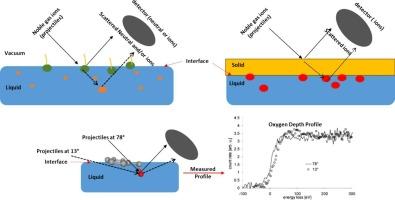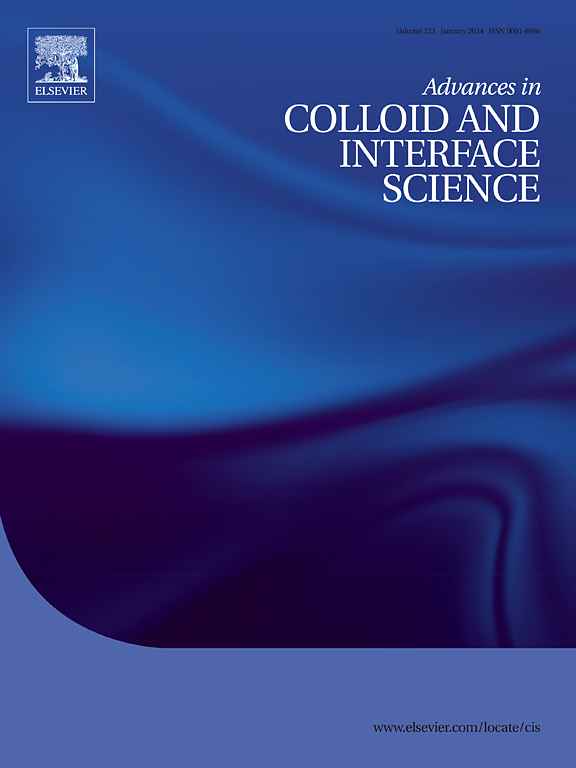惰性气体离子射弹在液体界面上的离子散射光谱研究综述
IF 15.9
1区 化学
Q1 CHEMISTRY, PHYSICAL
引用次数: 0
摘要
离子散射光谱法(ISS)是一种分析工具,当离子被用作射弹时,它能直接提供界面的结构、地形和原子成分信息。自 1967 年开发以来,离子散射光谱通常用于获取固体界面的定量信息。在过去的几十年中,ISS 已成为探测液体界面的重要技术,利用 ISS 对其进行研究的情况并不少见,中性撞击碰撞离子散射光谱(NICISS)更是如此。因此,本文总结了 ISS 的原理,重点介绍了 NICISS 及其数据评估,同时回顾了一些重要的汽液界面研究,这些研究为液体(包括离子液体)的分子取向、原子(或溶质)的组成和分布以及电荷随深度的变化提供了直接信息,从而获得了大量热力学信息。利用 ISS 可以获得 1-2 Å 的高深度分辨率(取决于实验的性质)。这些例子凸显了 ISS 的重要性,并显示了其在与特定离子效应、气溶胶和海水液滴中的大气反应,甚至确定重金属离子和全氟烷基物质 (PFAS) 等环境污染物归宿相关的研究中的应用潜力。此外,还讨论了 ISS 在研究高蒸汽压液体和探测液-液界面等埋藏界面方面的一些局限性,同时介绍了在探测固-液界面方面取得的进展。本文章由计算机程序翻译,如有差异,请以英文原文为准。

A review of ion scattering spectroscopy studies at liquid interfaces with noble gas ion projectiles
Ion scattering spectroscopy (ISS) is an analytical tool that provides direct structural, topographical, and atomic compositional information at interfaces when ions are used as projectiles. Since its development in 1967, ISS is commonly used to obtain quantitative information about solid interfaces. Over the last couple of decades, ISS has emerged as an important technique to probe liquid interfaces and their studies employing ISS has become not uncommon, more so with Neutral impact collision ion scattering spectroscopy (NICISS). Therefore, here the principle of ISS with a particular focus on NICISS and its data evaluation are summarised while reviewing some important studies at vapor-liquid interfaces that provide direct information for molecular orientation of liquids (including ionic liquids), composition and distribution of atoms (or solutes) and charges as a function of depth to gain vast variety of thermodynamical information. Employing ISS such information can be achieved with high depth resolution of ∼1–2 Å (depending on the nature of the experiment). These examples highlight the significance of ISS and show potential for its application for studies related to specific ion effects, atmospheric reaction in aerosol and sea water droplets, and even determining the fate of environmental pollutants like heavy metal ions and per-fluoroalkyl substances (PFAS). Furthermore, some limitations of ISS are also discussed relating to investigation of high-vapor pressure liquids and probing buried interfaces like liquid-liquid interfaces while presenting progresses made in probing solid-liquid interfaces.
求助全文
通过发布文献求助,成功后即可免费获取论文全文。
去求助
来源期刊
CiteScore
28.50
自引率
2.60%
发文量
175
审稿时长
31 days
期刊介绍:
"Advances in Colloid and Interface Science" is an international journal that focuses on experimental and theoretical developments in interfacial and colloidal phenomena. The journal covers a wide range of disciplines including biology, chemistry, physics, and technology.
The journal accepts review articles on any topic within the scope of colloid and interface science. These articles should provide an in-depth analysis of the subject matter, offering a critical review of the current state of the field. The author's informed opinion on the topic should also be included. The manuscript should compare and contrast ideas found in the reviewed literature and address the limitations of these ideas.
Typically, the articles published in this journal are written by recognized experts in the field.

 求助内容:
求助内容: 应助结果提醒方式:
应助结果提醒方式:


